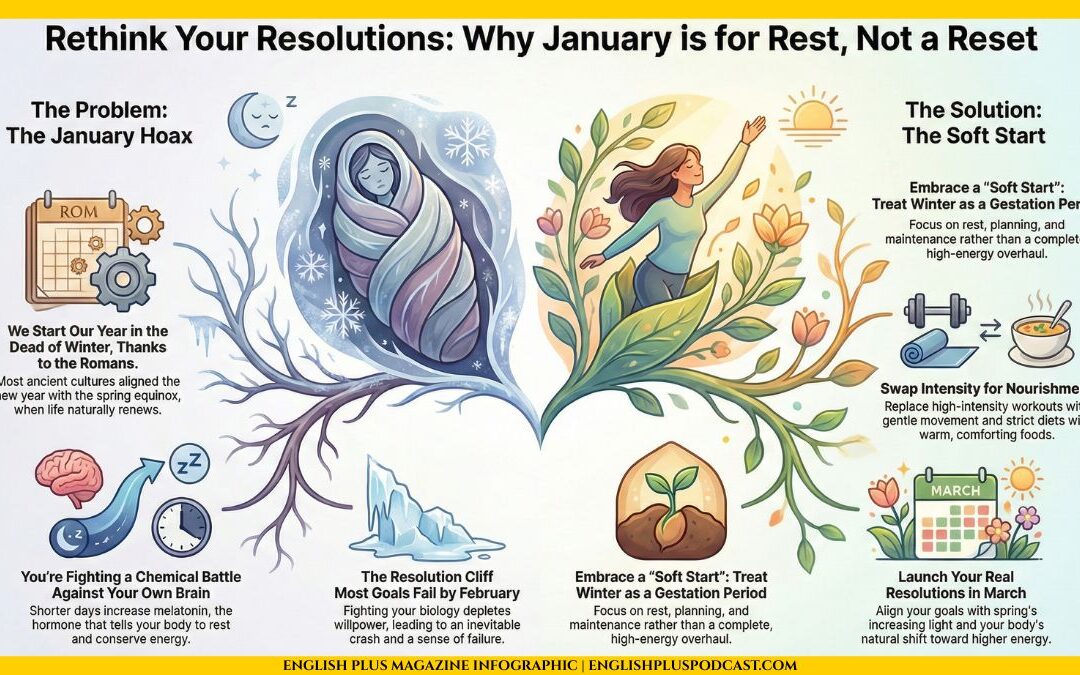Practice Worksheet
Transcript
Disclaimer
I am using an automatic transcript service as it is not possible for me to do it on my own and I cannot afford human transcription at the moment. The service claims to have about 95% accuracy, which means there will still be some mistakes, so my apologies for having a less than perfect transcript, but I hope I can afford human transcription soon and I will solve this problem. However, the service is pretty good, and the transcript is almost perfect.
Transcript
Welcome to an episode from English plus podcast today. It’s about grammar elementary, and this is the first episode from this series, which we will dedicate to talking about grammar at the elementary level. I would like just to tell you that if your level of grammar is higher than this. We have the grammar intermediate and the grammar advanced series that you can find an English plus podcast as well.
[00:00:34] And before we start, let me remind you that you can become a patron of English plus podcast and receive a PDF worksheet for every single episode we publish every day. So now without further ado, let’s start with our very first episode in this series, grammar elementary. And this episode is going to be about verb to be am is are first, we are going to meet Lisa and Lisa is going to tell us a couple of things about herself.
[00:01:08] And from what she says, we will be introduced to the use of M is. R or verb to be of course, in the present. So let’s see. My name is Lisa. My name is Lisa I’m 22. I’m 22. I’m American. I’m from Chicago. I’m American. I’m from Chicago. I’m a student. I’m a student. My father is a doctor and my mother is a journalist.
[00:01:52] My favorite color is blue. My favorite sports are football and swimming. I’m interested in art. I’m not interested in politics. So. Here. We can see that Lisa told us a bit about herself and we can see that she used verb to be in every sentence. She used to tell us about herself, and now we’re going to learn how we can use verb to be ourselves.
[00:02:30] If we notice, sometimes Lisa said I am, or I’m when she was talking about herself. And then when she talked about other people, she said, my father is, and my mother is when she talked about her favorite sports. She said, my favorite sports are, so we have these three forms of verb to be M is an R when do we use these forms?
[00:03:01] And with which pronouns do we use M is, or are. Let’s find out first, let’s talk about verb to be the form of verb to be in affirmative. When I want to talk about, I, I use M I say, I am, or we can make it shorter and we can say I’m I apostrophe M I’m. And it has the same meaning of course, but we can say it in the full form I am, or in the short form.
[00:03:37] I’m I apostrophe M what about, Hey, if we want to talk about, Hey, what do we say? Do we say he, em, no, we say he is, he is. Or the short form is he’s apostrophe S he’s. And what about Xi? If we want to talk about she do we use is as well. Yes, we do. We say she is. She is. Or if we want to make it short, we say she’s apostrophe S she’s and the same goes for it.
[00:04:20] It is, it is. Or for short, we say it’s. It’s apostrophe S it’s. And what if we want to talk about we do we still use is, or M no, we use our, we say we are, or for short we say we’re and that is apostrophe, R E we’re. And the same goes, if we want to talk about you, you are. Or your, for short, your U apostrophe, R E your and the same for they, they are, they are, or for short, we say there, they apostrophe R E there.
[00:05:14] So we say, I am he sheet it is you. We, and they are. But that was the form that we use in affirmative. What about if we want to say negative because it’s not always that I am from the United States because I am not. That’s when I want to use negative. I say I’m not from the United States. I am not interested in football.
[00:05:44] I am not interested in politics, et cetera. So. How do we make the same forms we talked about in negative? What about the first one? We said, we said, I am I’m. That is the affirmative form. What if we want to use it in negative? We say, I am not. Or we can make it short by saying I’m not, I am not. Or I’m not.
[00:06:13] What about he is? Or he’s. How do we make this negative? Of course we can add not. And we say he is not, or he’s not, but here we have a special form that we can use as well. Besides he’s not, we can say, Hey isn’t so we can say he’s. And then we add not as a separate word, or we can say he, I S N apostrophe T he isn’t.
[00:06:47] And it has exactly the same meaning. So you can use he’s not, or he isn’t. What about she? Is it the same? Of course we say she is, or she’s in affirmative, but in negative we say she is not. She’s not, or she isn’t. And the same for it is, or it’s we say it is, or it’s an affirmative it negative. We say it is not, it’s not, or it isn’t now what about we are, and we are, we are.
[00:07:26] And we’re, and that is the affirmative form of our, how do we use that in negative? We say we are not. So it’s the same thing we add not after M after is, or after our, or if we want to use the short form, we say we are not. Or like, isn’t this one word that we put together as a short form, we have one for our nut.
[00:07:54] We can say eight R E N apostrophe T. And we say, we aren’t. We aren’t the same goes, of course for you. Are we say you are not your not, or you aren’t, you aren’t the same goes for, they are, or their, we say they are not, they’re not, or they aren’t. So. That being said, it’s so beautiful. Yes. We know. Now what is the form of verb to be in affirmative and negative, but to understand that in a better way, we should look at some examples and see how verb to be is used in real sentences.
[00:08:41] Let’s start with this first sentence. I’m cold. Can you close the window, please? I’m cold. I am cold. Can you close the window please? So here we can see that we used em and here the short form of M apostrophe M because the subject is I we’re talking about, I, I am cold or I am cold. Another example, I’m 32 years old.
[00:09:12] My sister is 29. I’m 32 years old. My sister is 29. So here we used two forms of verb to be, we used em and we used is we used M at the beginning, because again, I am talking about, I, I am, I’m 32 years old, but when I talk about my sister, I didn’t say my sister am. I said my sister is because if we think about it, my sister is she.
[00:09:49] My sister is 29. She is 29. Of course we have to use words like that instead of he. And she, because if I just say here she is 29, you will not know who she is. If I don’t introduce her first by saying her name or saying who she is, you will not know. But even when I say my sister, we know that my sister is the same, like saying she, so I should use is as a form of verb to be in this case.
[00:10:24] And now for another example, Steve is ill he’s in bed. So he will use his and his again, but with the short form. But remember it’s just the same. And it’s up to you to use the full form. Or the short form back to our example here, Steve is ill. He’s in bed. Steve is ill. Why do I use is here it’s Steve? Yes, but if you think about Steve, if we want to replace it with one of the pronouns, which one is it?
[00:10:59] Steve is, uh, he, so he is ill. Steve is ill. And then when we continue, we said, he’s in bed. And now for another example, my brother is scared of dogs. My brother is scared of dogs, so. We use is here in this example. Why do we use is in this example, I’m talking about my brother, but think about it, my brother replace it with one of the pronouns we learned about, should it be a he or a she or an it?
[00:11:37] Of course, my brother is human. So we cannot use it because we use it only when we talk about non-human. My brother is a human. So either he or a she, and of course, because my brother is male. I use he, and we know that we use is with he. So my brother is scared of dogs because it is the same, like saying he is scared of dogs.
[00:12:05] And now for another example, it’s 10 o’clock. You’re late again. So he will use two short forms. The first four is when we said it’s and the second four are when we said you’re late again. So here it’s obvious because we used it is, and you are so it’s 10 o’clock and your late again. And now let’s take a look at another example and, and I.
[00:12:35] Our good friends. Well, wait a minute. Didn’t we say I here shouldn’t we use em instead of our, how do we say I R well, we don’t say I R because we didn’t say I alone. We said Anne and I, and, and I is not I alone. And I means we. And with we, we use our, when I say somebody and I, John and I, Tom and I, Sarah and I, and, and I, we, and here we should use our, and that’s what we did and I are good friends.
[00:13:22] And now for another example, your keys are on the table. Your keys are on the table. So here we used our, but why did we use our, we’re talking about your keys. If we want to replace your keys with one of the pronouns we learned about which one is the best replacement for your keys? Is it it? No, because it is singular.
[00:13:49] And here we’re talking about keys. I’m not talking about only one key. I’m talking about keys. So the best replacement for your keys is they and with they, we know that we use are, so your keys are because that has the same meaning of Z are on the table. And now for one more example, I’m tired, but I’m not hungry.
[00:14:17] I’m tired. But I’m not hungry. Well, by now we know that we use M with eyes, so that’s not a big deal. But look at the sentence. The first part is affirmative. The second part is negative. I’m talking about, I am tired. Yes, I am tired. But do I want to eat? No, because I’m not hungry. That is negative. I’m not hungry.
[00:14:45] I don’t want to eat. I’m not hungry. Let’s take a look at another example using again, affirmative and negative. Now we’re talking about Lisa. We said, Lisa, isn’t interested in politics, right? That’s Lisa that we met at the beginning of this episode, Lisa, isn’t interested in politics. She’s interested in art.
[00:15:12] She’s interested in art. That’s what she likes the most. She likes art. She is interested in art, but she is not, or she isn’t interested in politics. And what about James here? We have an example about James James. Isn’t a teacher, he’s a student, but I’m telling you, you look at James and you think. That James is a teacher and I’m telling you, no, that’s not true.
[00:15:45] That’s not right. James isn’t is not a teacher. He’s a student. And again, we use isn’t with James because James is a, Hey. He isn’t. So with hate, we use isn’t if we want to talk about negative and now let’s see one more example. Those people aren’t English, they’re Australian, those people aren’t English.
[00:16:13] They’re Australian, those people, aren’t English. Why do we use aren’t here? Because those people, they are not, they aren’t English. And I’m telling you that in negative because they are not English. They are not from England. They’re not from England. They are Australian they’re Australian. And now for one more example, it’s sunny today, but it isn’t warm.
[00:16:42] Well, you look outside and you see the sun. It’s sunny. It is sunny, but it’s still cold. It isn’t warm. It isn’t warm. It is sunny, but it isn’t warm. So that being said, we have examples about how we use the present form of verb to be M is, are both in affirmative and negative in sentences, but I will have to add three more examples for three common words that we use with verb to be.
[00:17:15] And these three words are very commonly used in everyday conversation. These words are that there and here I’ll give you the examples. And we will see how we use them with verb to be, to give specific meanings. Thank you. That’s very kind of you, you hear that all the time. Thank you. That’s very kind of you, well, we know thank you obviously, but that’s very kind of you, it’s not that very, that is.
[00:17:44] But usually people use the short form here and they say, that’s very kind of you. That is very kind of you to thank you for something you did for them. And another example with there, when we say, look, there’s Chris, there is Chris. Look, there’s Chris. We also use it with there when we want to point. At something or someone like in this example, we’re pointing at Chris, look, there’s Chris.
[00:18:16] And when you want to give something to somebody, you don’t go and say, take it. It’s rude to say it this way. Instead of saying, take it, which is rude. We have a polite way using here and here we use it with verb to be here’s your key and here, because it’s a key, it’s just one we use is. If we say keys, we should say, here are your keys.
[00:18:42] But in this example, we have, here’s your key here is your key. And that is just a way to be polite. When you want to give something to people, here’s something you want to be polite and we can use here. So we can use that there and here with verb to be for these three special meanings. That was everything for today.
[00:19:04] Thank you very much for listening to the episode so far. I hope you found the information interesting, and I hope by now you can use verb to be correctly in your sentences. Remember that you can find the full transcript of this episode in a link. I will leave in the description. So go to the description of this episode, take the link.
[00:19:22] And read the transcripts specially in places where you might have missed something. And there is also the PDF worksheet that you can get and practice the things we learned today. If you to become a patron of the show on Patreon, support our show and invest in your own English learning. This is your host, Danny.
[00:19:43] Thank you very much for listening to another episode from English plus podcasts. I will see you next time.









0 Comments